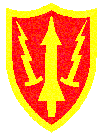
Between 1954 and 1974 many USA cities were ringed by Nike missile sites. These were ground-to-air missiles, intended to protect against attack by enemy bombers. The first versions of the missiles were armed with high explosive shrapnel warheads, so they could bring down the target even with a near miss - although in the days before electronic countermeasures, the missiles could easily have made direct physical contact with their target, making any warhead superfluous. Later versions of the missiles could be armed with 30 Kton nuclear warheads, in case there were more bombers than missiles. The nuclear warheads could also be used against ground targets.
Each Nike installation was split into a radar/control site, high on a hilltop for good visibility, and a launch site somewhere lower down and a mile or two away for better protection. The two sites communicated either by buried cable or by microwave; if the latter, they had to be in line of sight with each other. Aside from the differing site requirements, another reason for separating the control site and the launch site is that one of the control radars had to stay locked onto the missile. If they were too close together, the radar dish could not physically turn fast enough as the missile left the ground.
One peculiarity of the system was that it had a minimum range as well as a maximum - if the target was too close to the launcher, within about two miles, it could not be hit. Because of this the installations were sometimes placed in pairs, each able to cover the other's dead zone. In the SF area, SF-87 and SF-88 were such a pair.
Although the system has long since been decommissioned, many of the launch sites and control sites remain. This web site lists all of them in the San Francisco Bay Area.
A few Nike links:
